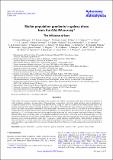Files in this item
Stellar population gradients in galaxy discs from the CALIFA survey : the influence of bars
Item metadata
| dc.contributor.author | Sánchez-Blázquez, P. | |
| dc.contributor.author | Rosales-Ortega, F.F. | |
| dc.contributor.author | Mendez Abreu, Jairo | |
| dc.contributor.author | Pérez, I. | |
| dc.contributor.author | Sánchez, S.F. | |
| dc.contributor.author | Zibetti, S. | |
| dc.contributor.author | Aguerri, J.A.L. | |
| dc.contributor.author | Bland-Hawthorn, J. | |
| dc.contributor.author | Catalán-Torrecilla, C. | |
| dc.contributor.author | Cid Fernandes, R. | |
| dc.contributor.author | De Amorim, A. | |
| dc.contributor.author | De Lorenzo-Caceres Rodriguez, Adriana | |
| dc.contributor.author | Falcón-Barroso, J. | |
| dc.contributor.author | Galazzi, A. | |
| dc.contributor.author | García Benito, R. | |
| dc.contributor.author | Gil De Paz, A. | |
| dc.contributor.author | González Delgado, R. | |
| dc.contributor.author | Husemann, B. | |
| dc.contributor.author | Iglesias-Páramo, J. | |
| dc.contributor.author | Jungwiert, B. | |
| dc.contributor.author | Marino, R.A. | |
| dc.contributor.author | Márquez, I. | |
| dc.contributor.author | Mast, D. | |
| dc.contributor.author | Mendoza, M.A. | |
| dc.contributor.author | Mollá, M. | |
| dc.contributor.author | Papaderos, P. | |
| dc.contributor.author | Ruiz-Lara, T. | |
| dc.contributor.author | Van De Ven, G. | |
| dc.contributor.author | Walcher, C.J. | |
| dc.contributor.author | Wisotzki, L. | |
| dc.date.accessioned | 2014-12-04T16:01:29Z | |
| dc.date.available | 2014-12-04T16:01:29Z | |
| dc.date.issued | 2014-10 | |
| dc.identifier | 158991816 | |
| dc.identifier | 6cb0b97b-533c-4720-897f-3bd93f505b05 | |
| dc.identifier | 84907851972 | |
| dc.identifier | 000344158500033 | |
| dc.identifier.citation | Sánchez-Blázquez , P , Rosales-Ortega , F F , Mendez Abreu , J , Pérez , I , Sánchez , S F , Zibetti , S , Aguerri , J A L , Bland-Hawthorn , J , Catalán-Torrecilla , C , Cid Fernandes , R , De Amorim , A , De Lorenzo-Caceres Rodriguez , A , Falcón-Barroso , J , Galazzi , A , García Benito , R , Gil De Paz , A , González Delgado , R , Husemann , B , Iglesias-Páramo , J , Jungwiert , B , Marino , R A , Márquez , I , Mast , D , Mendoza , M A , Mollá , M , Papaderos , P , Ruiz-Lara , T , Van De Ven , G , Walcher , C J & Wisotzki , L 2014 , ' Stellar population gradients in galaxy discs from the CALIFA survey : the influence of bars ' , Astronomy & Astrophysics , vol. 570 , A6 . https://doi.org/10.1051/0004-6361/201423635 | en |
| dc.identifier.issn | 0004-6361 | |
| dc.identifier.uri | https://hdl.handle.net/10023/5873 | |
| dc.description | We acknowledge financial support from the research projects under grants AYA2010-21887-C04-03, AYA2010-21322-C03-03 and AYA2010-15081 by the Spanish Ministerio de Ciencia e Innovación. | en |
| dc.description.abstract | While studies of gas-phase metallicity gradients in disc galaxies are common, very little has been done towards the acquisition of stellar abundance gradients in the same regions. We present here a comparative study of the stellar metallicity and age distributions in a sample of 62 nearly face-on, spiral galaxies with and without bars, using data from the CALIFA survey. We measure the slopes of the gradients and study their relation with other properties of the galaxies. We find that the mean stellar age and metallicity gradients in the disc are shallow and negative. Furthermore, when normalized to the effective radius of the disc, the slope of the stellar population gradients does not correlate with the mass or with the morphological type of the galaxies. In contrast to this, the values of both age and metallicity at ~2.5 scale lengths correlate with the central velocity dispersion in a similar manner to the central values of the bulges, although bulges show, on average, older ages and higher metallicities than the discs. One of the goals of the present paper is to test the theoretical prediction that non-linear coupling between the bar and the spiral arms is an efficient mechanism for producing radial migrations across significant distances within discs. The process of radial migration should flatten the stellar metallicity gradient with time and, therefore, we would expect flatter stellar metallicity gradients in barred galaxies. However, we do not find any difference in the metallicity or age gradients between galaxies with and without bars. We discuss possible scenarios that can lead to this lack of difference. | |
| dc.format.extent | 85 | |
| dc.format.extent | 29367183 | |
| dc.language.iso | eng | |
| dc.relation.ispartof | Astronomy & Astrophysics | en |
| dc.subject | Galaxies: abundances | en |
| dc.subject | Galaxies: evolution | en |
| dc.subject | Galaxies: formation | en |
| dc.subject | Galaxies: spiral | en |
| dc.subject | Galaxies: stellar content | en |
| dc.subject | QB Astronomy | en |
| dc.subject | QC Physics | en |
| dc.subject.lcc | QB | en |
| dc.subject.lcc | QC | en |
| dc.title | Stellar population gradients in galaxy discs from the CALIFA survey : the influence of bars | en |
| dc.type | Journal article | en |
| dc.contributor.sponsor | Science & Technology Facilities Council | en |
| dc.contributor.institution | University of St Andrews. School of Physics and Astronomy | en |
| dc.identifier.doi | 10.1051/0004-6361/201423635 | |
| dc.description.status | Peer reviewed | en |
| dc.identifier.grantnumber | ST/J001651/1 | en |
This item appears in the following Collection(s)
Items in the St Andrews Research Repository are protected by copyright, with all rights reserved, unless otherwise indicated.

